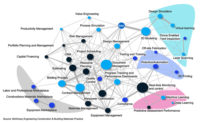“Our first project was analysis of goods movements at the Fulton Fish Market,” he says. Asked for consultaing help at $6 an hour, he came up with an analysis that prompted Urbitran to pay him $12 an hour.
In 1980, now armed with a doctorate degree, he joined Urbitran full time, with teaching stints at Manhattan College. Six years later, he was offered the job of traffic commissioner, serving Mayor Ed Koch. It would mean a political position for a non-political engineer and a pay cut. “But I had been in the U.S. for 16 years, and I didn't feel I belonged as much as I wanted,” says Horodniceanu. “I had only taken, but I did not contribute.” So he took on the public servant position—and quickly learned how ruthless New York City media scrutiny can be along with the city's rough-and-tumble politics. It prepared him well.
“We were looking for able people who were not politically involved,” says Ross Sandler, then the Dept. of Transportation commissioner. “He left a prosperous business to come and head that bureau. Mike was very aggressive on behalf of city workers. He was not the kind of government official who sat in the office. Government often has a lot of difficulty telling the truth. He never had a problem telling the truth.”
When Horodniceanu's political term ended, Berger and Urbitran both wanted him back. He chose Urbitran, which AECOM bought 18 years later.
The sale was not easy for a firm that felt like a family, says Ayala Malinovitz, Horodniceanu's chief of staff. When she first worked at Urbitran, she recalls, “I wasn't sure after two months, but we talked things over about how I like to work and how he likes to work. Sometimes he gets too involved, maybe aggravates people. He wants to know all the little details. You have to learn to work with him. He asks you questions. He is really interested in everything.”
“He is remarkably calm in the toughest environments,” says Schwartz. “Early on in the SAS, micromanaging was needed. People were doing what they always did, without giving their all to the political or public process. He changed the narrative. Until then, the attitude was that you can't make an omelet without breaking a few eggs. Michael wants to keep the chickens happy and also not break the eggs.”
944 Horodniceanu is born in Bucharest, Romania 1961 Moves to Israel; decides to be an engineer1963 Enters the Israeli military;he serves for 2.5 years.1966 Enrolls at the Technion-Israel Institute of Technology and graduates 4 years later with a B.Sc. in civil engineering 1967 Participates in the Six-Day War1968 Gets married.1970 With wife Bat-Sheva, moves to the United States, where he obtains a job with Berger-Lehman, a subsidiary of Louis Berger1973 Graduates from Columbia University with a M.Sc. in engineering management1975 Joins New York Polytechnic University in Brooklyn as a project director for a technology research study to transfer “system safety” from NASA to all modes of civilian transportation1975 Joins several professors at the nniversity in a new traffic engineering firm, Urbitran. Five years later (1980), he joins Urbitran full-time while also getting a full time appointment at Manhattan College in the Civil Engineering Dept.1978 Receives his Ph.D. in transportation planning and engineering1986 MH is offered and accepts the position of traffic commissioner at the New York City Dept. of Transportation1990 Rejoins Urbitran and leads its growth from $5 million a year to $36 million a year through 20082008 MTA Chairman Elliot Sander convinces MH to join MTA and take the position of MTACC president












